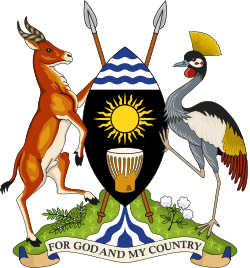Conservation in Uganda
Conservation in Uganda is the protection and sustainable use of the country's rich natural resources. It became a significant movement during the British colonial period in the early 20th century and continues to play a major role in Uganda's political economy, as it underpins the tourist industry accounting for a fifth of the country's exports.[1]
Uganda's 60 conservation protected areas harbor populations of numerous critically endangered species.
History of conservation
British Protectorate (1894-1962)
Active concerted management of wildlife in the Uganda Protectorate began in 1923 with the formation of the Elephant Control Department. The object of this organization was to reduce the damage to peasant agriculture by limiting the size and range of elephant populations. Culling programs killed an average of 1000 elephants per year.[2]
International Agencies
Wildlife Conservation Society

The Wildlife Conservation Society began conservation work in Uganda through conducting biological surveys of savanna parks in 1957 . Since then WCS has continued to provide funds for conservation almost every year up to the present despite the era of Idi Amin and the civil wars that followed.[3]
During the 1970s and 80s, they supported conservation of Kibale Forest, which became a national park in 1993 . WCS has supported the building of research and management capacities of Ugandans through aiding student research projects, helping to develop the Institute of Tropical Forest Conservation (ITFC), and more recently providing training to the Uganda Wildlife Authority (UWA) and National Forest Authority (NWA) staff.[3]
WCS is currently supporting projects that build the capacity of Ugandan protected area managers. Working with UWA they have developed a monitoring and research plan for every national park and wildlife reserve in Uganda.[3]
A census of the mountain gorilla populations over the last two years have shown increases in the numbers both in Bwindi (320) and the Virungas (380), bringing the total world population to just 700. Zoning of the forests is necessary so that fewer valuable areas can be accessed by local people for firewood, medicinal plants and other non-timber forest products. WCS also supports the Institute of Tropical Forest Conservation (ITFC) to undertake applied research on mountain gorilla conservation challenges, the effects of hard edges on long-term viability of forest islands, and the effectiveness of conservation strategies involving local people.[3]
Threats
The major threats to protected areas include poaching for bushmeat, illegal timber harvesting, charcoal burning and encroachment for farmland. Each of these has degraded protected areas over the past 40 years and led to reduced numbers of wildlife. Better protection in the 1990s has led to a slow but steady increase in many large mammal numbers, but some continue to decline.
Protected areas
Uganda has 60 protected areas, including nine national parks: Bwindi Impenetrable National Park, Kibale National Park, Kidepo Valley National Park, Lake Mburo National Park, Mgahinga Gorilla National Park, Mount Elgon National Park, Murchison Falls National Park, Queen Elizabeth National Park, Rwenzori Mountains National Park, and Semuliki National Park.
Wildlife
Uganda is home to a vast number of species, including a population of mountain gorillas in Bwindi Impenetrable National Park, gorillas and golden monkeys in Mgahinga Gorilla National Park, and hippos in Murchison Falls National Park.[4]
See also
Notes
- ↑ World Bank 2011.
- ↑ Meredith 2001, p. 126.
- ↑ 3.0 3.1 3.2 3.3 Wildlife Conservation Society 2012.
- ↑ Watching Wildlife: East Africa, Kenya, Tanzania, Uganda, Rwanda. Lonely Planet. 2009.
References
- Meredith, Martin (2009-04-27). Elephant Destiny: Biography of an Endangered Species in Africa. PublicAffairs. ISBN 9780786728381.
- Wildlife Conservation Society (2012). "Uganda". Retrieved 2012-08-05.
- International Trade Centre (2011). "Trade Map". Retrieved 2012-08-05.
Further reading
- James Kalema; Henk Beentje. (2012). Conservation checklist of the trees of Uganda. Richmond, Surrey, UK : Kew Pub. ISBN 9781842463772
External links
| ||||||||||||||||||||||||||||||
| |||||||||||||||||||||||||||||||||||||||||
| ||||||||||||||

